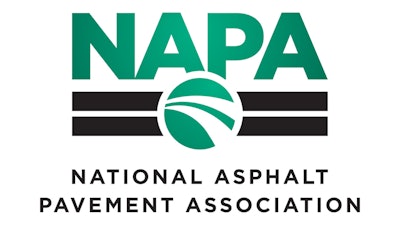
In Washington, D.C. this week, the National Asphalt Pavement Association’s future leaders convened over legislative priorities that include minimizing regulatory burdens and adequate funding for the Highway Trust Fund and airport infrastructure investments.
About 70 members of NAPA’s Impact Leadership Group met for their annual conference, where they learned about the latest industry issues and networked. Many are young professionals who own or work for paving companies or other firms tied to the industry.
On Thursday, they went to Capitol Hill, where they fanned out to meet with Congressional representatives and their staff members as NAPA strengthens its advocacy efforts.
Among the most urgent priorities for this Impact Leadership Group was to urge Congressional representatives to fix the Highway Trust Fund, which is increasingly unable to maintain current spending levels for highway and transit programs.
 Howard Marks
Howard MarksHoward Marks, NAPA vice president for environment, health and safety, had told the group earlier that the timing is right for a push to secure appropriate legislative language in the next Congress.
In an address Wednesday, Marks stressed the reason that the future NAPA leaders were in Washington, D.C. was “to get things done,” and ensure that regulatory burdens, such as trucking hours-of-service regulation – which govern how much time drivers can spend driving on duty behind the wheel – are minimized for the asphalt industry.
Other key topics included providing contractors flexibility in providing safer work zones, working with OSHA on minimizing industry burdens of the Silica Rule and asphalt fumes classification.
“We need to advocate our positions and highlight the benefits of our industry to provide the legislators to provide this to the legislators and the regulators and the true partnership kind of effort,” Marks told the group.
“This industry has a great track record right now. I think the more we communicate and highlight the benefits of our industry, the more we’ll relief or concessions we can get, especially in the next couple of years.”
FAST Act and the Highway Trust Fund
NAPA is joining with other industry groups to ask Congress to fulfill highway commitments for the Fixing America’s Surface Transportation (FAST) Act. It authorizes highway and public transportation funding investment through Fiscal Year 2020.
Lawmakers face a choice between finding new sources of income for the surface transportation program and settling for a smaller program, NAPA leaders say.
Given that the Highway Trust Fund has enough resources to fully fund the FAST Act’s authorized levels – and that investment levels are well below the nation’s surface transportation needs – the group members are requesting that FY 2019 appropriations process provide for this, at least:
- $45.27 billion for federal-aid highway improvements
- An additional $4.4 billion in general fund resources to enhance investments levels in the transportation discretionary grant account and in block grant formula funding
- No additional rescissions of unobligated highway contract authority
NAPA says the Highway Trust Fund’s tax base is eroding, and that downward momentum could continue as demand for gasoline decreases with the introduction and adoption of more fuel-efficient and electric vehicles.
Also, according to the group, the fund increasingly relies on general funds in a gradual shift away from user fees. For example, Congress transferred about $141 billion in general revenues to the Highway Trust Fund eight times from 2008 through 2015 to maintain spending levels o about $45-50 billion a year.
This approach breaks the longstanding principle of users paying in highway finance, NAPA says.
Another funding gap projected for 2021
In March 2016, the Congressional Budget Office estimated that $107 billion in additional funding would be needed to maintain current spending levels plus inflation from 2021 through 2026.
The FY 2019 investment levels authorized include the $45.27 billion for highway improvements, which represents a $1 billion increase.
It also authorizes $12.3 billion for the public transportation systems, which includes $2.3 billion for capital investment grants, the group learned.

President Trump’s infrastructure package did not include a fix for the Highway Transportation Fund. So Thursday, the Impact Leadership Group members planned to deliver these messages as they met with Congressional representatives and staff:
- The 2015 FAST Act temporarily stabilized federal highway and transit investments but that door is soon closing.
- States could begin scaling back planned projects for 2019 due to the uncertainty caused by the next Highway Trust Fund revenue shortfall, which is anticipated to begin in October 2020.
- States rely on these federal highway funds to support, on average, more than half of their capital spending on highways and bridges.
- Any Highway Trust Fund revenue solution should be permanent, user-based and enough to support federal surface transportation investments.
Rising airport infrastructure demands
The group members also pushed for increased government investments in airport infrastructure.
This is an important topic for the asphalt industry, given that airports are expected to have more than $20 billion in annual capital needs between 2017 and 2021.
Airline passenger levels are projected to grow from 776 million in 2015 to 1.1 billion by 2034, according to Federal Aviation Administration figures.
Despite those needs, the Airport Improvement (AIP) was cut from $3.52 billion in 2012 to $3.35 billion in 2012. And it’s stalled at that same level for six years now, NAPA says.
Meanwhile, the Passenger Facility Charge cap has remained at $4.50 since 2000.
The Impact Leadership Group supports a House proposal for $1 billion more in through appropriated general funds. The group also supports a Senate reauthorization proposal for recurring AIP funding for airport improvements.
The group is also calling for the elimination of the $4.50 cap on the Passenger Facility Charge, which allows airports to impose a fee on air travelers.
Eliminating that cap would allow airports the flexibility to raise resources for their specific infrastructure needs, according to NAPA.











